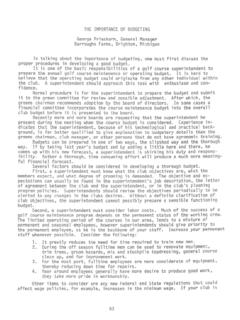Transcription of Financial performance management Transforming public ...
1 Financial performance managementTransforming public sector budgeting and management2 Financial performance management : Transforming public sector budgeting and managementState and local governments are contending with a confluence of issues as the American economy continues to recover from the 2008 Financial crisis. While tax revenues remain under pressure, taxpayers are demanding increased investment in infrastructure, schools, and social programs. States and municipalities also face uncertainty over federal funding as the makeup of the Congress shifts, and tough decisions loom regarding Medicaid expansion and the future of public sector pensions. Along with greater demand for quality services, government organizations are under increasing pressure to improve transparency, including demonstration of links between strategy, resource allocation and results. Many states are improving the quality of their reports and making them available electronically.
2 And, some are working to follow higher federal budgeting standards established by the Government performance and Results Modernization Act of 2010 (GPRAMA). While states that can provide proof of performance are better positioned to obtain future federal funding, migrating to the standards is a huge leap from meeting the requirements of the original Government performance and Results Act (GPRA) passed in 1993. Many jurisdictions are ill-equipped to meet today s challenges. Gartner estimates that up to 80 percent of budget officers, especially in smaller government jurisdictions, still rely primarily on spreadsheets and homegrown systems to support analysis, forecasting and budget Along with slowing down the budgeting process, these conditions heighten the risk of errors. These factors suggest the need for a more comprehensive approach to budgeting and performance management a migration from basic Financial planning to Financial performance management (FPM).
3 This paper discusses how an FPM approach can help state and local government meet 21st century performance management is the vision of a strategic, organization-wide budget, built from the ground up through interdepartmental collaboration, and achieving full transparency to taxpayers and other Critical Capabilities for Government Budget Planning Products by Gartner (G00214312) September 7, 2011 Financial performance management Transforming public sector budgeting and management 3 Financial performance ManagementWhat is FPM?FPM is a framework to increase the delivered value for a given taxpayer dollar. FPM goes beyond budget planning to incorporate performance management and outsourcing, strategy management , Financial consolidation, and Financial and management reporting and disclosure. It is the vision of a strategic, organization-wide budget, built from the ground up through interdepartmental collaboration, and achieving full transparency to taxpayers and other stakeholders.
4 FPM is an ambitious undertaking that requires fundamental changes to traditional state budgeting paradigms far more than just deploying a new software application. FPM can challenge even the most sophisticated state finance organizations because no single formula for success exists. Each state needs to assess its current environment, reengineer affected processes, redesign the finance organization, and implement new (or adapt existing) supporting technology. As such, FPM requires an intricately woven combination of process design, organizational change management , technological partnership, and public -private insight. Process design it's imperative to reengineer budgeting from end to endA primary impediment in state budgeting transformation efforts is the inability to document, optimize, and ultimately automate the entire budgeting process. Instead, Knuth s premature optimization often occurs documenting a portion of the process and then attempting to optimize and automate only that portion.
5 Across the breadth of a transformation effort undertaken in such bite-size pieces, technological stratification, and stage obsolescence can occur, impeding achievement of desired results. Additionally, vendor creep, which can be attributed to opportunistic vendors attempting to increase the scope of a project and their associated revenues, can result from a portioned , the budgeting process needs to be addressed in its entirety, from forecast and analysis modeling through publishing, scorecarding, dashboarding, and reporting and data management . Premature optimization is the root of all evil. Donald Knuth, renowned computer scientist2 Financial ConsolidationFinancial ReportingBudgetingStrategic Planning2. Structured Programming with go to Statements, ACM Computing Surveys, Vol 6, No. 4, Dec. 1974 Cost Modeling4 Effective end-to-end government budget process design takes into account not only the funding levels required to provide for key social programs, but the changes necessary under a variety of different revenue production scenarios.
6 Lack of budgeting flexibility during the Financial crisis forced states to attain significant cost savings from public assistance and higher education, precisely the programs that needed bolstering to smooth the path to economic recovery. Process design in public sector budgeting involves multiple change factors in a single transformation program. Historically, government entities have used simple budgeting techniques and timelines planning by line item and program, and focusing on operating expenditure categories, usually over a single year an approach that lacks the fiscal agility demanded of state and local governments. Today, the budgeting process should be addressed in its entirety, from forecast and analysis modeling through publishing, scorecarding, dashboarding, and reporting and data management . Process redesign takes into account a broad spectrum of budgeting techniques and the need to manage data inflows and outflows.
7 Moreover, outcome-based budgeting is more involved than traditional budgeting , which often requires little more than tweaking the previous year s budget. Lawmakers should understand what outcomes their citizens really want and make educated guesses about how much and where to spend. Another challenge is demonstrating a reasonable connection between actions and outcomes. Whether enhancing child welfare, reducing prison recidivism, or protecting citizens from terrorism, today s public policy issues are often too complex for individual agencies to tackle on their own. Achieving these and other important societal outcomes requires the participation of multiple agencies across, up and down levels of government, as well as involvement from businesses and nonprofits. A broad process design addresses the issue of shared outcomes and helps equip decision-makers to identify and measure each agency s contribution to the desired outcome.
8 Organizational change management transformation fails without user adoptionPerformance-based budgeting is more than spreadsheets, scenarios, department codes, and flowchart arrows. It is collaboration among professionals in a defined organizational culture who share the goal of serving taxpayer needs at the lowest possible cost. As Drucker pithily suggests, dismissing the importance of culture can be the first step toward wasting an enormous time and fiscal resources on a strategy blind to organizational realities. The challenges that states encounter in implementing budget process transformation often point back to one critical misstep not bringing budget data managers, Financial and accounting professionals, project management experts, and information technology personnel together with process professionals to redesign the budgeting system from inception to delivery of return on investment (ROI).
9 Culture eats strategy for breakfast. Peter Drucker, renowned management consultant3 States often shortchange internal and external communications relating to the transformation, as well as compressing employee and citizen training and user acceptance testing. Compression cuts costs. This lack of attention to change management often has a direct impact on user adoption, which can significantly restrict the achievement of transformation goals and The Daily Drucker: 366 Days of Insight and Motivation for Getting the Right Things Done October 26, 2004, by Peter F. DruckerFinancial performance management Transforming public sector budgeting and management 5 Making matters worse, states often shortchange internal and external communications relating to the transformation, as well as compressing employee and citizen training and user acceptance testing. Compression cuts costs. This lack of attention to change management often has a direct impact on user adoption, which can significantly restrict the achievement of transformation goals and ROI.
10 Effective change acknowledges the need to enculturate a workforce in the realities of 21st-century budgeting , as well as providing adequate funding and resources, whether internal or external, to deliver related education and training. Much as businesses strive to be customer centric, government entities can become more citizen centric using performance -based budgeting . But that opportunity is often missed in the budget transformation process. With a workforce unaccustomed to citizen-centric behavior, paying attention to change management and resulting culture shift is crucial in large-scale service-improvement efforts. Technological partnership you don't have to go it alone As Gates reminds us, technology tends to make good things better and bad things worse. If processes are not thoroughly and soundly reengineered prior to automation, trouble often follows. Transformation can go awry without extensive collaboration between technology providers and budget and finance professionals, particularly in performance -based projects.



















